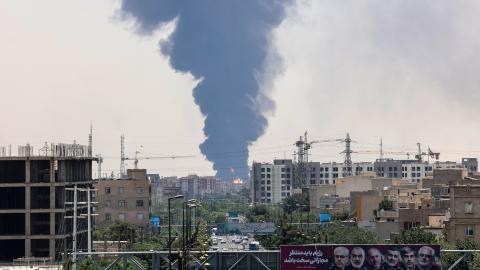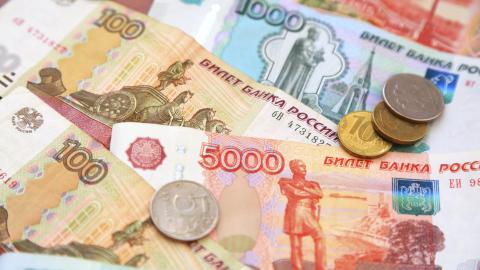Putin’s teetering and inflation-ridden economy is undermining his war effort and testing his people’s tolerance for suffering. Europe, the United Kingdom and the United States must work together to take advantage of this moment: tighter sanctions could accelerate the timetable for serious economic and possible political crisis in Russia. But does the West have the political capital and fortitude to cooperate in outlasting the irredentist Eurasian dictator?
As a key part of Putin’s effort to subdue Ukraine, he and his cronies have woven a narrative of overwhelming Russian economic and military strength to sap the determination of both the Ukrainians and their wavering supporters in the West. A hard and realistic look at the state of the Russian economy belies this false narrative and opens the window to a clearer understanding of the serious vulnerabilities the Russian dictator faces in the near term.
Even with an erratic American president, currently sowing doubts about continued US support, Europeans have sufficient economic and political levers to challenge and weaken the position of Putin. Presuming his continued belief in his own assessment of the balance of forces – and insistence on his own Carthaginian peace as a result – European resolve and assertion of economic advantage, along with military assistance, is needed to bring Trump back in alignment with erstwhile transatlantic allies.
Dubious Statistics
In service of his somewhat delusional assertion of economic strength and stability, Putin hides behind the deceptive economic data offered to the world by his regime. Their statistics are notoriously and transparently unreliable. Start with inflation: the Russian economic team, including the central bank, had to raise its published estimates of actual inflation to around 10% in recent months. Other data show rents up over 31% last year, mortgage rates are in the 30% range, and meat and vegetable prices are up 20% or more in each of the last two years. In its April “Financing the Russian War Economy”, the Stockholm Institute of Transition Economics estimates that inflation is twice the reported rate. The central bank’s benchmark interest rate has been held at 21%, adding to inflation and belying its officially reported level. Labor shortages – due to the war and to the loss of able-bodied young men fleeing the draft – are another major factor in the inflationary cycle.
The lion’s share of growth in the Russian economy is accounted for by the rapidly rising bill for the war (and domestic security). Official defense spending has doubled since the start of the war and is on track for 20% growth this year. The share of this sector too is obscured and disguised in official accounts. The best estimate seen by this author suggests that costs of the war now approach 40% of the official budget and 10% of GDP.1
Growth in the civilian economy is most likely negative when inflation is properly accounted for. But even official government statistics show that production of steel, food products, mining, beverages and paper all declined in 2024 and into 2025. Auto production is down by two-thirds since the start of the war. Russian experts and economists Vladimir Mirov and Anders Aslund use the term “stagflation” to characterize the current state of the country’s economy
The Bottom Line
Financial repression undermines the private sector and visits mounting hardships on the Russian consumer. Interest paid on short-term deposits has been forced upwards to 20% or more in early 2025. Commercial banks are forced by authorities to lend at below market rates to defense-related firms. Over $400 billion in such loans have been issued and bank profitability has plummeted, threatening the solvency of the sector. Authorities in Moscow may be forced to compensate banks for these war-related loans in the event of default, further undermining their fiscal situation and driving inflation.
The increasingly stressed government budget is compelling authorities to lower pension and social welfare payments. Putin and his predecessors, of course, have been famously indifferent to the welfare of the Russian people. Life expectancy – even before covid and the debilitating war in Ukraine – stood at around 54 years; that is, at the same level of Haiti and in the lower half of averages in the less developed world.
The conduct of the war has shown the value of technological innovation. There is growing admiration for the flexibility and inventiveness of the Ukrainian military and manufacturing sector. Russia has a high level of education attainment and a well-known history of advanced technology, especially in the weapons industries; but beyond this sector, Russia has proven to be a surprising laggard. Political scientist and demographer Nicholas Eberstadt has noted that despite its reputation for genius, it remains far behind most advanced and middle-income economies in terms of invention and application of new technology to practical uses. Further exacerbating this lack of dynamism in the civilian economy is Putin’s recent expropriation of private property and firms.2
Between 2000 and 2020, Russia accounted for only 0.3% of all foreign patents awarded in the United States. India had 2% and China 3% of this measure. Eberstadt noted that the 148 million souls in Russia (2020 data) produced about the same number of US patents as the state of Alabama, around 700. This compares to 183,000 awarded to all Americans. Which Russian brands of consumer goods, commercial airliners or digital services are even known in the West? Lack of innovation in non-defense sectors partially explains the weak performance and standard of living in Putin’s Russia.
The growing cost of the war along with persistent stagnation in the civilian economy has caused looming crisis in official finances. This is the biggest threat to Putin’s ability to prolong the war. At the most visible level, the official national budget shows a net deficit of around 2% of GDP over the last two years. A jump in oil prices at the start of the war allowed Moscow to finance the war in its first year, but that could not last forever.
Playing the Sanctions Card
Western sanctions, especially on exports of natural gas and crude oil, served to cut annual income from energy exports and opened the fiscal deficit. Fossil fuel export revenues normally account for roughly one-third of total taxes. Strong production of oil in North America and the complicity of Saudi Arabia in keeping prices low will almost certainly continue to handicap revenues derived from Russian oil exports. Some estimates of the production costs in the Urals zone indicate that they are closer to $70 per barrel than to the sanctioned rate of $60.3 It is also worth noting that the cost of recruiting soldiers for the Russian side and compensating its casualties approaches 1.5% of GDP.
Putin has reluctantly resorted to raising taxes and fees to meet current obligations. These include corporate profit, small business and individual income taxes, and new fees on mineral extraction. The state budget has phased out subsidies for mortgages, making them all but unaffordable for the vast bulk of the population. As noted earlier, social welfare support has been reduced. Despite these new fiscal measures, the official budget remains in deficit.
The National Wealth Fund (NWF) of the Russian state, built on the income of oil and gas export-related revenues, had balances around $600 billion (nearly 30% of GDP) at the start of the war; this served as a backstop for meeting the stressed war budget. Half of this fund is held in Europe, however, and has been frozen by European authorities. The remaining total of liquid assets (a considerable amount is held in illiquid assets, such as shares of Russian state firms) has already been depleted by 75% since the onset of the war. Aslund estimates that the remaining funds will be depleted well before the end of the year.
The only other viable option to pay for the war and other current obligations is borrowing, through the issuance of bonds. Russia already features an expansionary monetary policy, which contributes to the persistence of inflation, according to Milov. The central bank risks hyperinflation if it monetizes more debt. Foreign purchases of Russian sovereign bonds have largely disappeared since the start of the war. Only 4% of all national bonds are held by non-Russian sources.
Given these limitations, as long as Putin persists in his aggression against Ukraine he will have to rely on domestic bond sales. But this source is weak and tottering on the brink of usefulness. Several new offerings in late 2024 and early 2025 failed, and net financing of sovereign debt was negative in the first two months of 2025, as calculated by Milov. More recently, a bond with a proffered coupon north of 15% “failed to find any acceptable bids” on May 7.4
Western sanctions have not only cut Russian revenues derived from fossil fuel exports; they have also slowly undercut new oil and gas development (notably the Arctic 2 LNG facility) and limited some weapons production. Much of Moscow’s commercial airline fleet is grounded due to shortages of key parts created by the sanctions. Without Chinese, Iranian and North Korean military technology, as well as some other assistance, Putin’s war machine would be in even greater danger of severe shortages. For example: the Russian military has had to cannibalize commercial appliances and autos for computer chips needed for weaponry.
The Success of Sanctions
Although there are many loopholes in the sanctions applied to fossil fuel exports, they have forced Russian producers to accept lower prices and to go to extreme lengths to blunt their impact on logistics. The “failure of sanctions” narrative is as much a myth as an overstatement as that of low inflation and a blazing economy.5
In these circumstances, the continuation and deepening of sanctions by transatlantic allies can significantly complicate Putin’s ability to string out the war and achieve his major objectives. If Trump continues to equivocate on playing a leading role in this effort – or backtracks on previous US commitments – Europe is well positioned to step in and to exploit Putin’s growing economic vulnerabilities.6
The EU is already responsible for managing frozen NWF funds, and it hosts the SWIFT trade settlement system – the global standard for financial information. As a result, sanctions utilizing the SWIFT network or the wealth fund must have EU concurrence. This has been key to ensuring the success of most sanctions, and any newer or strengthened ones cannot succeed without European support.
Before the war, the EU was Russia’s largest trading partner, absorbing 38% of its exports. It was also a major supplier of capital investment and exports of heavy machinery to the Russian Federation. Even though most of its pipeline gas imports have been cut off, it remains a large buyer of Russian gas and refined petroleum products made with Russian crude oil in third countries such as Turkey and India. Last year, the European Union bought 52% of Russian LNG exports. It also allows Hungary and the Slovak Republic to accept Russian pipeline gas. European leadership will be especially important in tightening limits on the oil and gas sectors as it has been the largest importer of those commodities from Russia for decades. EU loopholes for the import of refined petroleum products and tolerance for imports of pipeline gas and liquid natural gas are one major source of continued Russian external revenues to support its war effort.
Ramping Up the Effort
Increased North American production of both oil and gas, less growth in Chinese imports, and Saudi Arabia’s apparent tolerance of lower oil prices will keep prices below those in the early years of the war. Because of this, the oil price cap is largely irrelevant and allies’ fears of a price spike destabilizing their economies are remote. The United States has ample LNG capacity to replace EU demand from Russia. A concerted action to sanction the remaining channels of Russian oil and gas sales to the west will consequently have minimal impact on global markets, while diminishing one of the final sources of earnings that continues to power Putin’s war effort.
Tougher sanctions on both fossil fuel exports and technology acquisition will affect China in significant ways, especially if secondary sanctions on those banks that facilitate Russian trade in both arenas are agreed by transatlantic partners. Since one of Trump’s clear priorities is rebalancing trade with China, he ought to be supporting European leadership on secondary sanctions on the Middle Kingdom.
Trump’s belated agreement on minerals cooperation, along with Putin’s obstinance on any credible ceasefire, gives some hope that the US president may be open to European initiatives to cooperate more fully in support of Ukraine. Treasury Secretary Scott Bessent closed the much-touted minerals and China trade deals and appears to have the attentive ear of Trump. After the deal with Kyiv was signed, Bessent suggested that it is “a tacit security guarantee, because of the economic partnership.”
In summary, Putin’s teetering and inflation-ridden economy is already undermining the war effort and testing tolerance for suffering both among the general public and among the oligarchs. His ability to finance the aggression without risking hyperinflation by opening the (digital) printing presses is nearing its limits. Europe is well placed to lead in tightening sanctions enough to accelerate the timetable for serious economic and possible political crisis in Russia. In so doing, Brussels (with help from London) could strengthen Trump’s resolve for stronger support for Kyiv. The question, however, remains: does the West have the political capital and fortitude to cooperate in outlasting the irredentist Eurasian dictator?
















